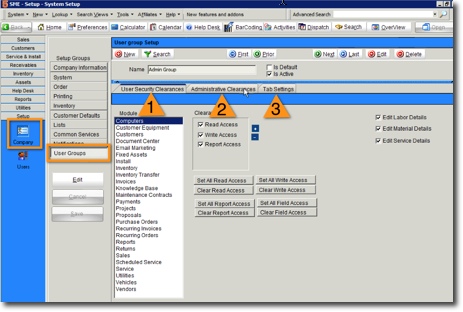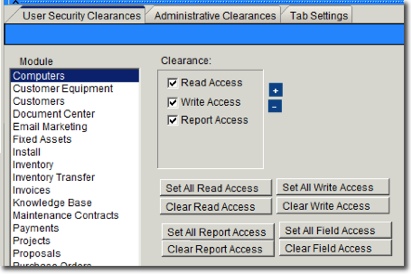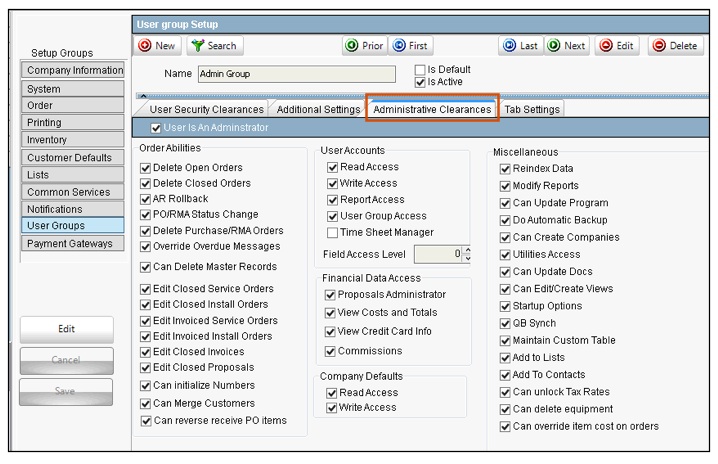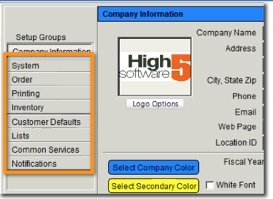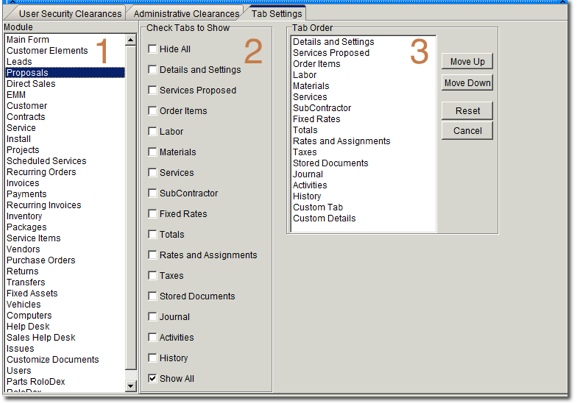User Groups
Each user group has permissions within SME. Assign users to a user group and the user will inherit the permissions assigned in the group. Examples of different user groups you can create are:
- Admin Group - by default this group is created
- Sales Group – this group may have rights to all modules except for receivables and only read access to the inventory module.
- Full Rights Group – this group has access to all modules and all tabs and features within each module
Setup User Groups
- Go to Setup module > Company.
- Click User Groups.
There are two user groups created when by default including the Admin Group and the Default user group. You can also create additional groups as needed by clicking New.
1 - User Security Clearances - Set users access to the modules in SME
2 - Administrative Clearances - Assign various administrative permissions to the User Group such as the ability to delete orders or invoices.
3 - Tab Settings - Hide tabs and rearrange the order of tabs throughout the modules in SME
User Security Clearances Tab
On the User Security Clearances tab you assign read, write, and report access to the modules in SME.
Select the module and check Read, Write, or Report Access.
- Read Access - user can access the module and read/view records in the module
- Write Access - user can edit records in the module
- Report Access - user can click the Print/Email button in the modules to print or email the record.
If the user has broad access to all modules:
- Click Set All Read Access, Set All Write Access and Set All Report Access.(circled in image to the right)
- Then select the module you want to restrict permissions for and uncheck the read, write or report access under Clearances.
Edit Labor Details - If checked, user can add and edit labor items on orders. If unchecked, they won't be able to add or edit labor on orders.
Edit Material Details - If checked, user can add and edit material items on orders. If unchecked, they won't be able to add or edit material on orders.
Edit Service Details - if checked, user can add and edit service items on orders. If unchecked, they won't be able to add or edit service items on orders.
Land on Grid - This determines where your cursor lands when you open a search window. If checked, it lands on the data in the grid. If not checked, it lands in the first column filter cell which is usually preferred.
Dispatch Locked - If checked, user cannot change labor on the dispatch calendar
Bar Code Reconciliation - that is related to Barcode for SME - an add-on software for SME that works with Motorolla MT2000 series barcode devices.
Allow adding new inventory from orders - If this is checked, the user will be able to add a new inventory item from the service or install order. In order, click New Material. In search window click cancel. In the add item to order window that opens, enter the name, number, description. Click OK. The following message will prompt you: Inventory Item not found. Add it to Inventory? Click Yes. You will find the item added to your inventory item list.
Administrative Clearances Tab
On the Administrative Clearances tab you will assign various administrative permissions to a user group such as the ability to delete order, edit order, view costs and totals etc.
The Order Abilities section is where you can choose permissions related to adding and deleting information.
- AR Rollback - Allows users to rollback an invoice (Actions > Rollback Invoice)
- Can Delete Master Records - A master record is the record showing on the Details & Settings tab in any module. So they cannot delete that but can delete items on that record.
- Can Initialize Numbers - SME will generate an invoice number or order number, but with this option check, users can enter their own invoice number or order number.
- Can Merge Customers - You can merge customers into one another. So if company A is bought out by company B you can merge A into B. All records will be merged however the address info is not changed.
- Can reverse receipt PO Items - With this permission, a user can go to a PO, right click on an item that has been received into stock, and reverse the receipt.
The User Accounts section provides access to the user accounts in SME.
- Field Access Level is related to custom fields. You can assign an access level to each custom field and this is where you assign what level of access the user group has to the custom fields.
The Financial Data Access section provides users access to financial information such as commissions, costs and prices, and credit card info.
- Proposal Administrator - If checked user can see the Sales Commission field on a proposal.
- View Costs and Totals - If checked then the user can see the cost and price field on material, labor and services they add to orders.
- View Credit Card Info - If checked allows users access to credit card information.
- Commissions - If checked then user has access to commission summary on the totals tab on an order. They also see the commissions tab on the material, labor, and services added to an order.
The Company Defaults section provides users access to the Setup module > Company > Setup Groups (image below). This applies to all groups except user groups. Access to the User Group section of Setup module is determined under the User Accounts section.
The Miscellaneous section provides other permissions. A couple that are used frequently:
- Reindex Data - There is no reason to reindex in SME. SQL manages that very well. The only time you should reindex is when High5 may request you reindex and you can only perform it on the SQL server logged in as Admin.
- Can Update Program- Only the Admin login should have that enabled as it can only be done from the server.
- Utilities Access - with this permission, a user can access the Utilities module where you will find Price Book Editor, Payroll Items, Import and Export utilities, and various other utilities.
- Can Edit/Create Views- this allows user to create new search views in the search windows throughout SME.
- Add to Lists - allows users to add values to drop down fields directly in the field rather than going to the setup module.
- Add to contacts - Allows user to add contacts
- Maintain Custom Table - Gives the user the ability to setup the custom tables for the Custom Tabs. Utilities> Custom Tabs.
- Can Unlock Tax Codes - There is a check box in the taxes tabs on orders & invoices so taxes would not be updated if an order/invoice were to be edited after the tax rate was changed. Old behavior was the order/invoice would get recalculated if the order/invoice were touched
- Can Delete Equipment - If checked, user can delete equipment from the Customer Equipment Module
- Can override item cost on orders - If checked, user can change the cost of material items on orders
Tab Settings Tab
Use this tab to choose which tabs are available in each module for the user group. You can also arrange the tabs in the order you want on this tab.
1 - Choose the module
2 - Check the tabs you want visible
3 - Arrange the order of the tabs
Additional Settings tab
This tab is related to TechPortal for SME Settings. If you are using TechPortal, then this tab will be populated with the options once WebService is installed. Please see the TechPortal Settings page for a description of the options.
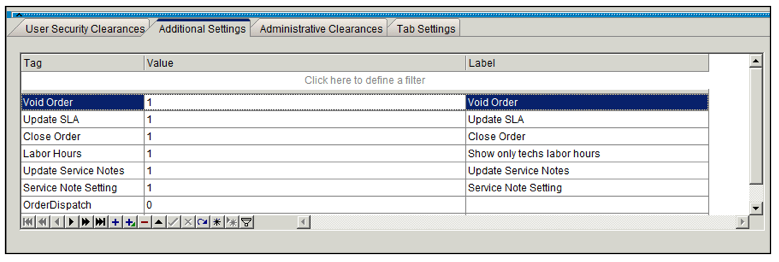
Assign User Group to your SME Users
1. Go to the Setup Module > Users.
2. Click Search > Search Active Users and select the user you want to edit.
3. On the Details and Settings tab, locate the User Group field. Select the user group you want to assign to user.
Add User Group on the fly
In a User record, you can type a new user group directly in the User Group field then hit 'Enter' on your keyboard. You will be asked if you want to add the new user group. Click Yes and a new user group is created. You will have to go to the User Group and set all the setting since the new user group will have access no module and no settings on the Administrative Settings tab.
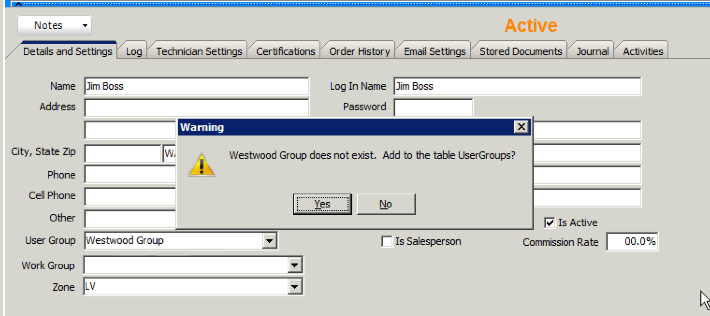
User Is An Administrator

If left unchecked setting Restricts group from:
- Restricted access on reports, search views, and custom fields
- Converting inventory from an inventory item to non-inventory item
- Clearing 0 count records from inventory items
- Deleting records from the inventory> Material Details tab
- Clearing inventory transactions from Inventory> Transactions tab
- Deleting an inventory record
- Access to system the overview functions in utilities
- Company overview (main form, overview button)
- Viewing journal notes
